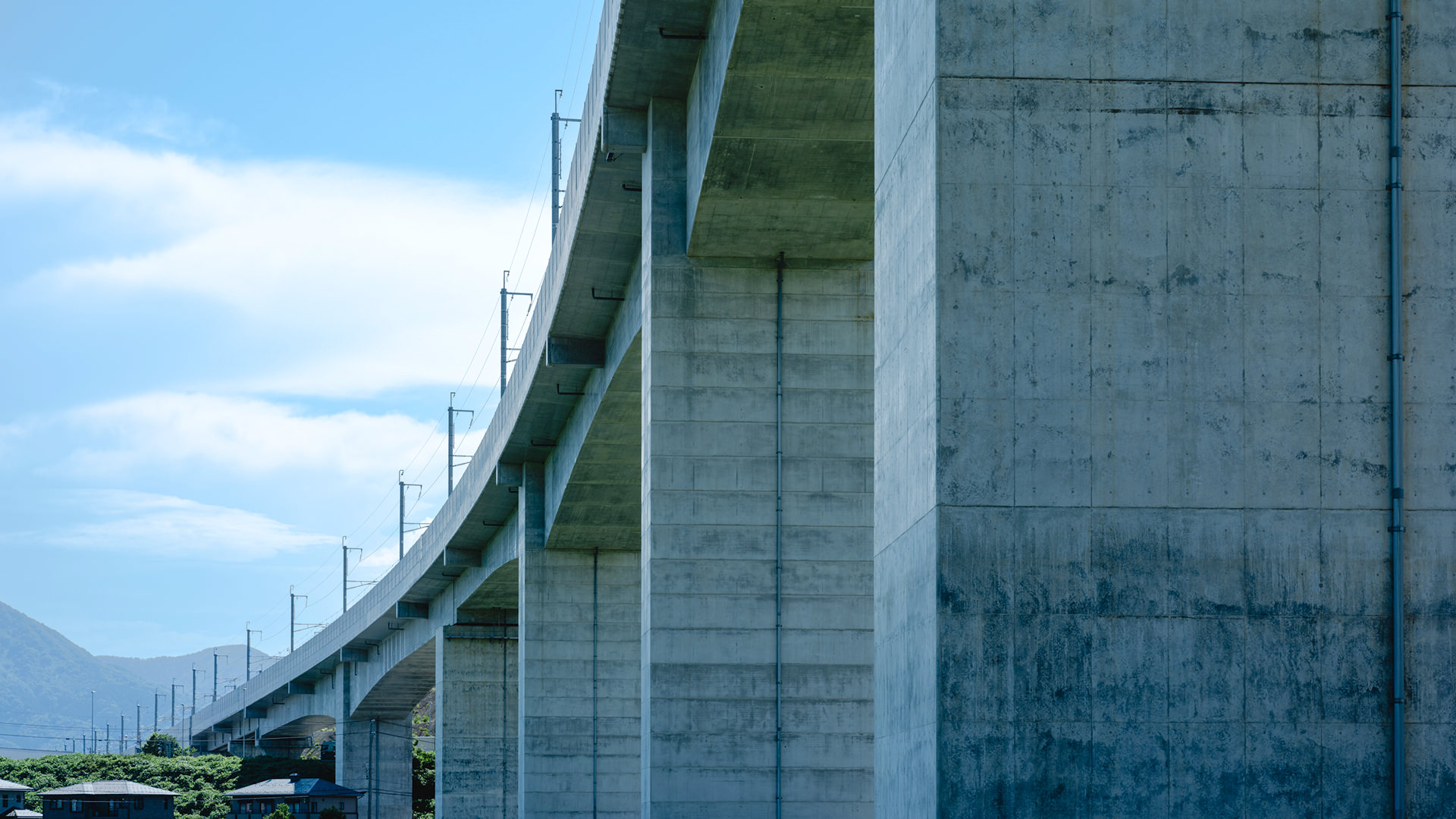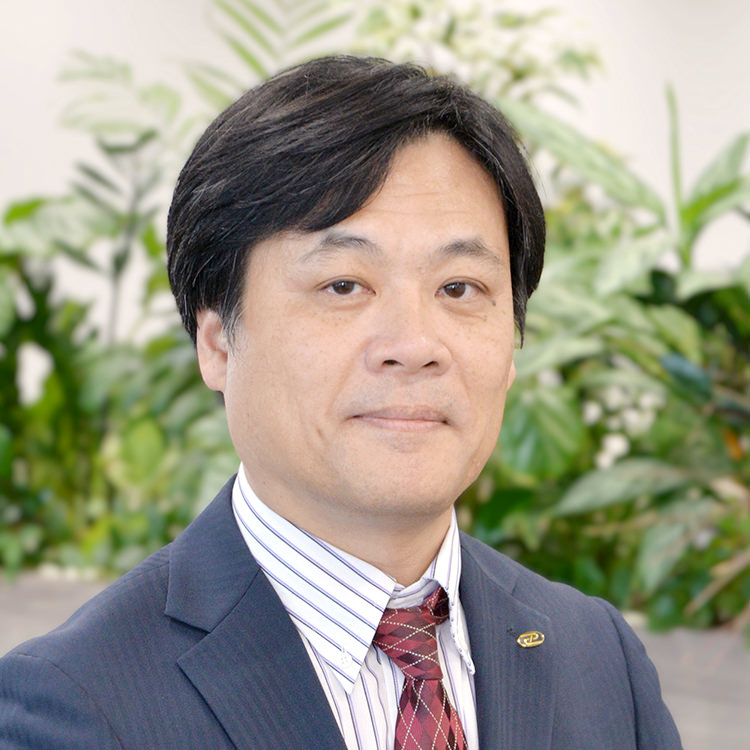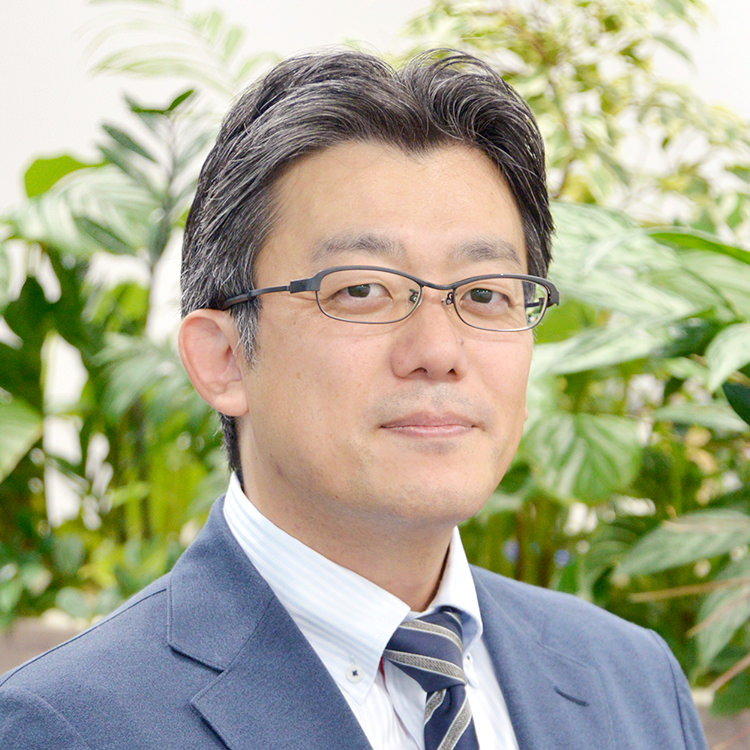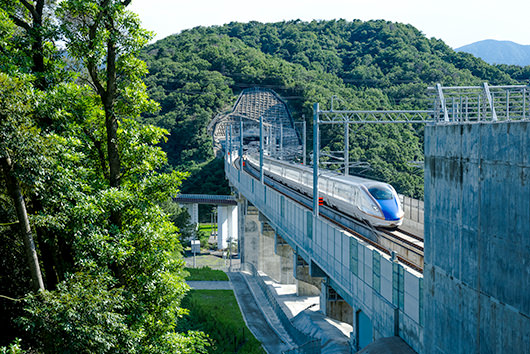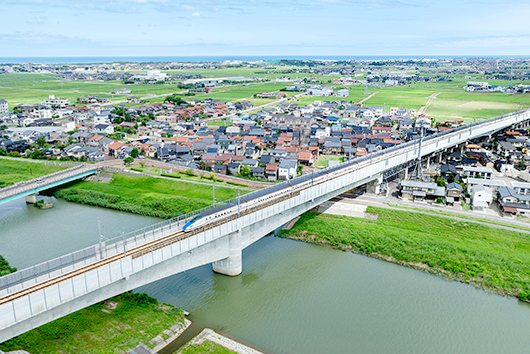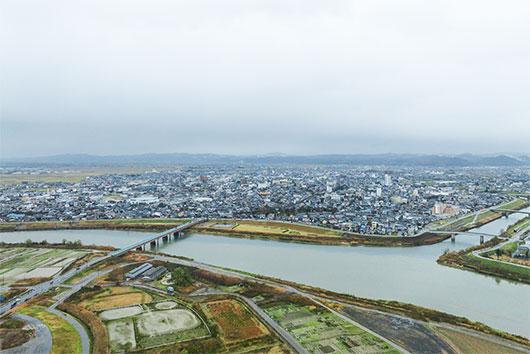The Hokuriku Shinkansen (total length approximately 690 km), which connects Tokyo and Osaka via Nagano and Kanazawa, opened its Kanazawa-Tsuruga section in March 2024. The construction work, which took 11 years and 8 months since the construction implementation plan was approved, faced various challenges, including measures against snow damage, overcoming soft ground, and consideration of the environmental impact on the Ramsar Convention on Wetlands-designated sites, but overcame them one by one, adding a new page to the history of Shinkansen construction. PACIFIC CONSULTANTS is also supporting this extension through a variety of services. In this three-part series, we will introduce three projects for which we were involved in the detailed design: the Okura Yoza Bridge, the Miyama Tunnel, and the Kakehashigawa Bridge.
Bridge with a pier's height of approximately 30m, rapidly constructed on soft ground
The Shinkansen, which travels at a speed of 260km per hour, requires extremely high precision in its bridge piers. The allowable deflection is only a few millimeters. This is why engineers who aspire to be civil engineers think, "I want to work on the Shinkansen someday." Furthermore, the Okura Yoza Bridge had to be built on soft ground with a maximum pier's height of about 30m. This was one of the most difficult projects in the long history of Shinkansen construction.
INDEX
- A bridge pier that blends in with the rural landscape
- The required bridge pier's height is a maximum of 30m, and on soft ground
- Multiple design changes made to enable rapid construction
- Applying knowledge gained from long-span PC bridges to the next generation
- Project Overview
A bridge pier that blends in with the rural landscape
The construction implementation plan for the Kanazawa-Tsuruga section was approved in June 2012. The design of the construction work, which will extend approximately 115 km, began sequentially, and PACIFIC CONSULTANTS has been awarded the projects for detailed designs for several construction sections. The Okura-Yoza Bridge is also one of them. A project team was immediately formed, including members from a group company of P.I.T. Co., Ltd.
The Okura-Yoza Bridge section is the construction section just before entering the terminal Tsuruga Station, starting at the exit of the Fukayama Tunnel and extending for approximately 700 m, including the end of the Tsuruga Bypass overhead bridge. Initially, the Japan Railway Construction, Transport and Technology Agency (hereinafter referred to as "JRTT"), which placed the order, presented a schematic design with the bridge piers lined up with a span of approximately 20 m. However, when Bunya IKEHATA, in Railway Planning Sec. of Railway Dept. (At the time, Bridge Structure Sec.) of PACIFIC CONSULTANTS, and Yosuke YOSHIZAWA in the same Bridge Structure Sec., saw this design, they thought the number of piers was too much.
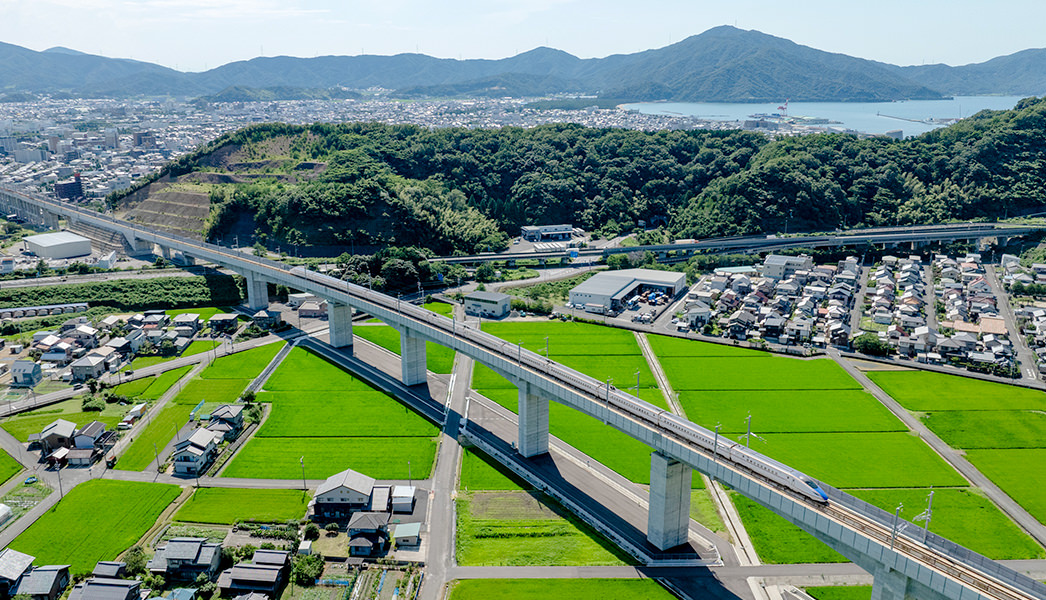
"The Okura Yoza section is characterized by a tranquil rural landscape with rice paddies spreading out in a small basin surrounded by low mountains on three sides. We wanted to avoid having a forest of concrete piers with 20m spans in this landscape. We approached the detailed design with the aim of reducing the number of piers as much as possible, and considered a plan to reduce the number of piers to about one-third of the initial outline design," said by IKEHATA. Reducing the number of piers by greatly increasing the span did not seem particularly difficult, but there were other design difficulties. One was the required height for the piers, and the other was the weakness of the ground. Neither of these were things that the two people had ever experienced in their work designing Shinkansen lines across the country.
The required bridge pier's height is a maximum of 30m, and on soft ground
In July 2012, just one month after the construction implementation plan between Kanazawa and Tsuruga was approved, the Naka-ikemi wetland, a low lying wetland located in the center of Tsuruga City and surrounded by three mountains (Mt. Tetzutsuyama, Mt. Nakayama, and Mt. Fukayama), was designated under the Ramsar Convention on wetlands, which regulates international wetland protection. According to the construction implementation plan, the Fukayama Tunnel passes through the designated area. The JRTT, the construction entity, decided to set up a committee with outside experts to conduct another impact study. Subsequently, the route of the Fukayama Tunnel was changed in response to the recommendations made by the committee. They decided to raise the elevation of the tunnel by up to 150 meters horizontally away from the wetlands and by up to 17 meters. The goal was to reduce the amount of water flowing into the wetlands from the mountains by putting the tunnel higher up in the mountains.
Because the tunnel is now at a higher elevation, the bridge piers near the exit of the Miyama Tunnel need to be 30m high. This is the highest pier height between Kanazawa and Tsuruga. From here, the bridge crosses two national highways just before Tsuruga Station and descends at a steep gradient of 26‰ to the station. The piers also gradually become lower, but still remain at a height of around 20m.
YOSHIZAWA says, "I have been in charge of the detailed designs for new Shinkansen lines, such as the Hokkaido Shinkansen and Kyushu Shinkansen, but bridge piers are usually around 10 meters high, and even the tallest are around 15 meters high. This has now been doubled. It's not just that the bridge piers are taller; they need to be strong enough to withstand the height, so the overall volume of the piers is larger. We have never built such huge piers for a Shinkansen project before."
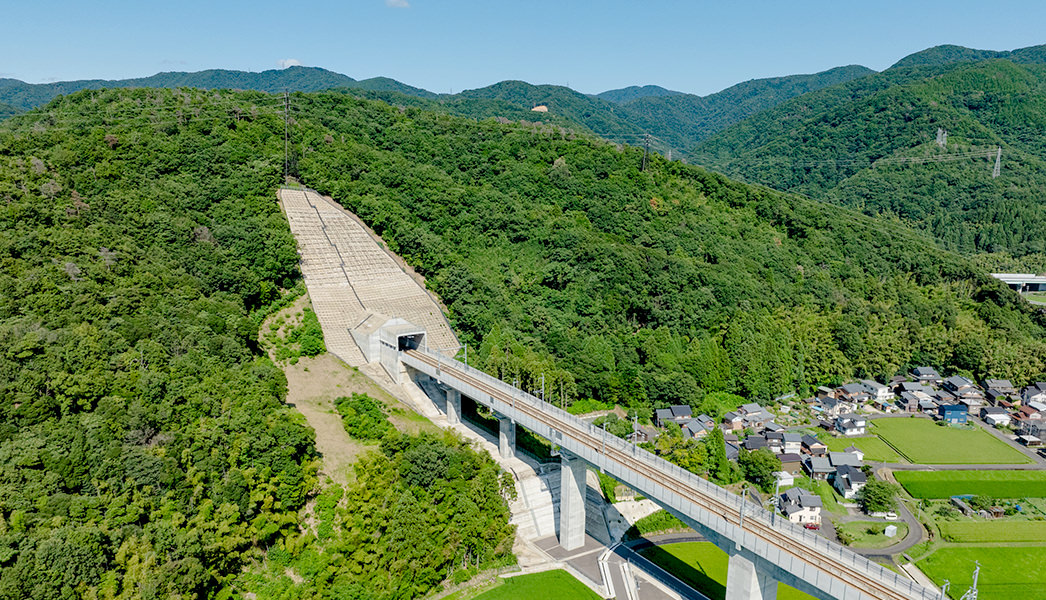
Moreover, there was also a problem of the ground.
The site is located in what is known as a drowned valley, which was originally a terrestrial valley that became a bay after sinking below the sea level due to subsidence of the ground and rising the sea level, and then became an alluvial lowland due to sedimentation. The geology is composed of alternating layers of sand, clay, and organic soil, and the ground was extremely soft, ranking second from the bottom in the eight-grade ground classification established by the Standard for the Design of Railway Structures. The base plane for seismic design was also deep and sloped due to the shape of the drowned valley. The irregular shape of the ground was expected to amplify earthquake ground motions, so detailed ground analysis was essential to the design. Aware of the enormous amount of calculation time and effort required, a ground response analysis using the Finite Element Method (FEM) was conducted. This method divides the ground into small elements and analyzes the overall behavior by quantifying and calculating the movement of each element. This method enables a detailed understanding of the ground movement during an earthquake over time and clarifies the performance required of the piles.
As a result of the study, we found that the longest foundation piles would need to be 63 meters long, with a maximum of 20 piles per pier. The longest piles up to date are 50-odd meters, so this is significantly longer than that. We interviewed several companies specializing in piles to determine if it was really possible to construct such long piles, and studied the construction method in detail. The footings, which are concrete slabs placed above the piles to support the footings of the piers in the soil, also had to be huge, about 20 m square. The scale of the project was so large that there was no precedent case for it. IKEHATA recalls, "We received inquiries from the client asking, "Are you sure you can handle this?""
Even the slightest flaw in the detailed design of the piles or piers would stop construction. There was only a very small margin of error allowed. Tsuruga Station is currently both the terminal and starting station, so the speed of the Shinkansen trains that run across the Okura Yoza Bridge, which is close to the station, is slow. However, if the extension to Osaka is realized, trains will also pass through Tsuruga, and at that time they will run across the bridge at 260 km/h. A high level of precision that could withstand that was required.
They managed to complete the design of the piers, but there were more issues to consider.
Multiple design changes made to enable rapid construction
Normally, once the detailed design is completed and construction begins, the design team has some free time. However, the Okura-Yoza Bridge site was different. Since it would not be possible to complete construction in time with the usual method, the construction method was repeatedly examined, and a revised design was necessary to accommodate the new construction method.
For example, in the construction of the bridge piers, a method using half precast members was adopted, proposed by the construction company. This involves dropping precast members about 1.2 meters high, which have rebars embedded in them at a factory, onto the main rebars assembled at the height of the pier, and then stacking them to create the surface of the pier, and then pouring concrete into the interior. Since there is almost no rebar assembly work on-site, this makes it possible to significantly shorten the construction period.
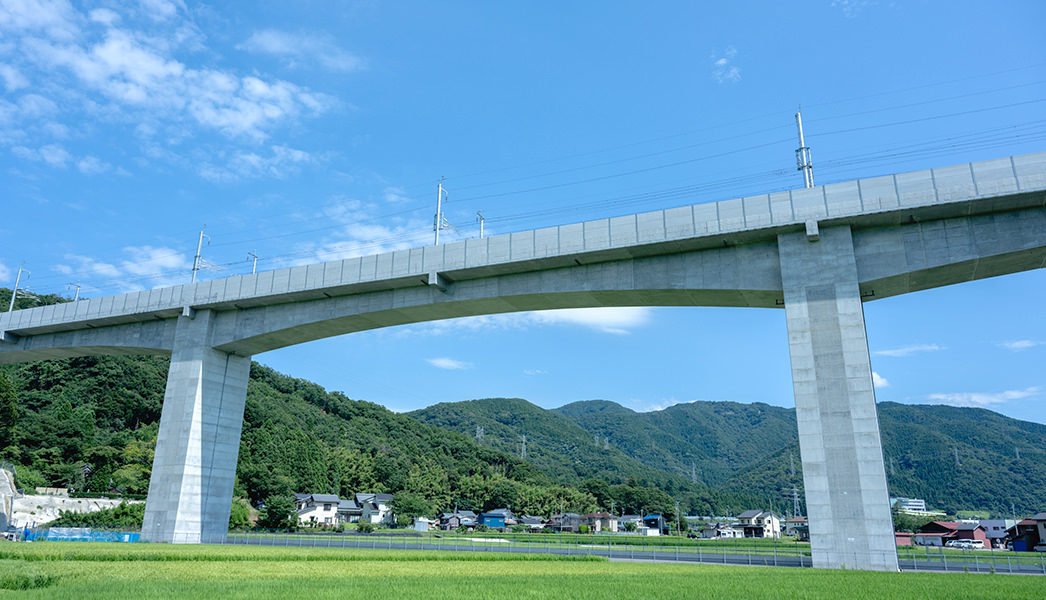
Furthermore, an extra-large mobile work vehicle was used for the erection of the superstructure. Normally, the superstructure is constructed using a large mobile construction vehicle known as a Wagen, which extends the bridge from a single pier in small arms on either side (overhang construction) and connects it in the middle. In this case, the longest construction block is 4m, and the bridge is extended in 4m increments. However, for the Okura Yoza Bridge, an even larger mobile construction vehicle was used, which extended the longest construction block to 6m, improving efficiency. Also, construction of the girder ends, known as side spans, is usually started after overhang construction is completed, but by making it possible to carry this out in parallel, the construction period was further shortened.
"Changing the construction method would have a major impact on the detailed design, such as changing the position of the rebar or the thickness of the concrete. The three parties : the client - the JRTT, the construction company, and us - the designers - held regular discussions to come up with ideas for the construction and revise the design, which allowed us to complete the work quickly," said by IKEHATA.
Applying knowledge gained from long-span PC bridges to the next generation
The Okura Yoza Bridge, which was more difficult to design and construct than previous Shinkansen construction projects was completed on schedule, with thanks to various ingenuity, leading to its opening on March 16th. Prior to the opening, YOSHIZAWA and other members of the project team took part in a test ride event which was open to residents living along the line, and they all agreed they were overwhelmed by the sight of the residents celebrating the long-awaited opening with big smiles on their faces.
This was also a highly successful project for Railway Dept. of PACIFIC CONSULTANTS.
By overcoming the soft ground to build huge bridge piers, carrying out unprecedented rapid construction, and working on a particularly long PC bridge *, Railway Dept. has accumulated new know-how and experience in Shinkansen design.
"By gaining further experience in designing long-span PC bridges for the Hokuriku Shinkansen, we have been ordered to provide detailed designs for 6 bridges for the 212-km extension of the Hokkaido Shinkansen, which is currently under construction, from Shin-Hakodate-Hokuto Station to Sapporo Station, and young engineers are working on the project. Because Shinkansen bridge design requires an extremely high level of precision, this is a significant opportunity to learn structural design techniques. If you can design Shinkansen bridges, you will be able to tackle any railway bridge, multi-level intersection, or road bridge without hesitation. I have always wanted young people to take on this role."
It was YOSHIZAWA who shouldered those expectations and joined the design work for the Hokkaido Shinkansen just two years after joining the company. YOSHIZAWA went on to be involved in the design of the Kyushu Shinkansen and Hokuriku Shinkansen, and is now leading a young team in the Hokkaido Shinkansen's extension to Sapporo.
"It is my role, having learned from my predecessors, to inherit what Railway Dept. has built and pass it on to the next generation. I want PACIFIC CONSULTANTS to be the company that people think of when it comes to designs for PC long-span bridges. I will continue to work hard together with young engineers."
Railway Dept. 's challenges will continue, connecting generations.
Project Overview
Track length: 125km (construction length: 115km)
New stations: Komatsu Station, Kaga Onsen Station, Awara Onsen Station, Fukui Station, Echizen Takefu Station, Tsuruga Station
Maximum design speed: 260km/h
Maximum steep gradient: 26‰
Process Schedule
- June 2012: Construction implementation plan (part 1) approved
- October 2017: Construction implementation plan (part 2) approved
- December 2023: Construction completion audit completed
- March 2024: Completion and opening ceremony



